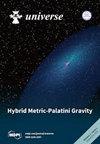排除基于非线性电动力学的宇宙学模型的综合研究方法
IF 2.5
4区 物理与天体物理
Q2 ASTRONOMY & ASTROPHYSICS
引用次数: 0
摘要
我们采用了一种综合研究方法来研究包含非线性电动力学(NLED)的宇宙学模型的动力学。这项研究基于对稳定性和因果关系等基本方面的同步研究,辅之以对相关模型的动力学系统研究,以及用于参数估计的贝叶斯推理。我们探讨了两个具体的 NLED 模型:幂律模型和理性拉格朗日模型。我们介绍了 NLED 与广义相对论耦合的理论框架,随后分析了各种 NLED 拉格朗日的稳定性和因果性。然后,我们进行了详细的动力学分析,以确定这些模型具有稳定性和因果性的范围。我们的结果表明,幂律拉格朗日模型经历了不同的宇宙学阶段,从麦克斯韦辐射主导状态演化到物质主导状态。对于包括麦克斯韦项在内的理性拉格朗日模型,在特定参数范围内观察到了稳定的因果行为,临界点表明了宇宙的演化路径。为了验证我们的理论发现,我们利用一整套观测数据进行了贝叶斯参数估计,包括宇宙计时器、重子声学振荡(BAO)测量和 Ia 型超新星(SNeIa)。两个模型的估计参数都符合当前宇宙的预期值,特别是物质密度ωm和哈勃参数h。我们的综合研究方法排除了上述模型对宇宙的适当描述。我们的研究结果强调了进一步完善和探索基于 NLED 的宇宙学模型的必要性,以便将它们完全纳入标准宇宙学框架。本文章由计算机程序翻译,如有差异,请以英文原文为准。
Combined Studies Approach to Rule Out Cosmological Models Which Are Based on Nonlinear Electrodynamics
We apply a combined study in order to investigate the dynamics of cosmological models incorporating nonlinear electrodynamics (NLED). The study is based on the simultaneous investigation of such fundamental aspects as stability and causality, complemented with a dynamical systems investigation of the involved models, as well as Bayesian inference for parameter estimation. We explore two specific NLED models: the power-law and the rational Lagrangian. We present the theoretical framework of NLED coupled with general relativity, followed by an analysis of the stability and causality of the various NLED Lagrangians. We then perform a detailed dynamical analysis to identify the ranges where these models are stable and causal. Our results show that the power-law Lagrangian model transitions through various cosmological phases, evolving from a Maxwell radiation-dominated state to a matter-dominated state. For the rational Lagrangian model, including the Maxwell term, stable and causal behavior is observed within specific parameter ranges, with critical points indicating the evolutionary pathways of the universe. To validate our theoretical findings, we perform Bayesian parameter estimation using a comprehensive set of observational data, including cosmic chronometers, baryon acoustic oscillation (BAO) measurements, and supernovae type Ia (SNeIa). The estimated parameters for both models align with the expected values for the current universe, particularly the matter density Ωm and the Hubble parameter h. However, the parameters of the models are not tightly constrained within the prior ranges. Our combined studies approach rules out the mentioned models as an appropriate description of the cosmos. Our results highlight the need for further refinement and exploration of NLED-based cosmological models to fully integrate them into the standard cosmological framework.
求助全文
通过发布文献求助,成功后即可免费获取论文全文。
去求助
来源期刊

Universe
Physics and Astronomy-General Physics and Astronomy
CiteScore
4.30
自引率
17.20%
发文量
562
审稿时长
24.38 days
期刊介绍:
Universe (ISSN 2218-1997) is an international peer-reviewed open access journal focused on fundamental principles in physics. It publishes reviews, research papers, communications, conference reports and short notes. Our aim is to encourage scientists to publish their research results in as much detail as possible. There is no restriction on the length of the papers.
 求助内容:
求助内容: 应助结果提醒方式:
应助结果提醒方式:


